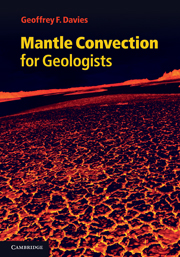Book contents
- Frontmatter
- Contents
- 1 Introduction
- 2 Context
- 3 Why moving plates?
- 4 Solid, yielding mantle
- 5 Convection
- 6 The plate mode of convection
- 7 The plume mode of convection
- 8 Perspective
- 9 Evolution and tectonics
- 10 Mantle chemical evolution
- 11 Assimilating mantle convection into geology
- Appendix A Exponential growth and decay
- Appendix B Thermal evolution details
- Appendix C Chemical evolution details
- References
- Index
5 - Convection
Published online by Cambridge University Press: 03 May 2011
- Frontmatter
- Contents
- 1 Introduction
- 2 Context
- 3 Why moving plates?
- 4 Solid, yielding mantle
- 5 Convection
- 6 The plate mode of convection
- 7 The plume mode of convection
- 8 Perspective
- 9 Evolution and tectonics
- 10 Mantle chemical evolution
- 11 Assimilating mantle convection into geology
- Appendix A Exponential growth and decay
- Appendix B Thermal evolution details
- Appendix C Chemical evolution details
- References
- Index
Summary
Thermal convection is driven by boundary layers. Buoyancy. How to calculate plate velocities – simple mechanical version. Interpretation of an oceanic plate as a thermal boundary layer. Estimation of plate thickness from thermal conduction. Plate velocities – thermo-viscous version. What is a Rayleigh number? Other useful numbers.
Convection is not familiar to many geologists, so before we get to mantle convection, which has some unusual features, we need to get to know convection in general. If we start from the right place, then convection becomes understandable in straightforward terms. Instead of it being something vague down there that makes things go around, we can know when to expect convection and what will control it.
The key to convection is that it is driven by boundary layers. I will focus for the moment on thermal convection (there is also compositional convection), so thermal convection is driven by thermal boundary layers. If we can identify a thermal boundary layer, and say something about how it behaves, we are well on the way to understanding the convection that it drives.
In the mantle, the relevant thermal boundary layers form at horizontal boundaries. Later we will look at why that is. For the moment, we can use Figure 5.1 as the simplest realisation of what I have just said. There is a hot thermal boundary layer along the bottom boundary of the fluid layer.
- Type
- Chapter
- Information
- Mantle Convection for Geologists , pp. 38 - 55Publisher: Cambridge University PressPrint publication year: 2011



